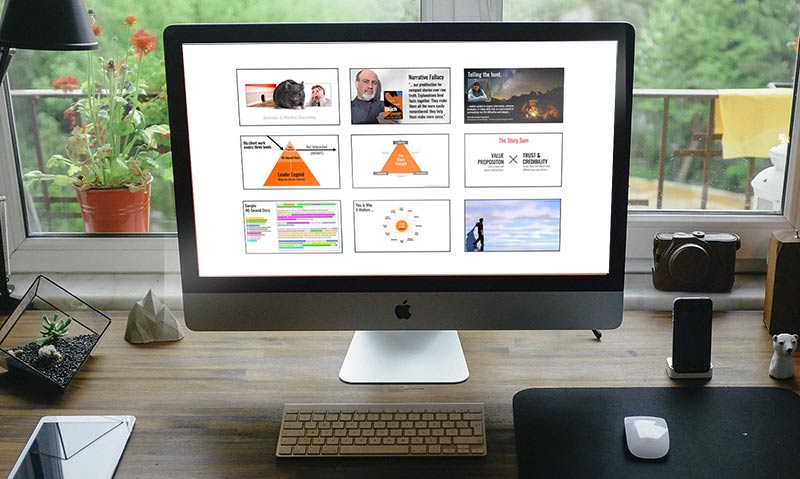“The greatest thing by far is to have a command of metaphor. This alone cannot be imparted by another; it is the mark of genius.”
– Aristotle, Poetics.
“A metaphor is a kind of lie to help people understand what’s true.”
– Terry Pratchett
I first took a deep dive into metaphor for selfish reasons. I wanted to level up that aspect of my skill and understanding. Great writers deploy them to powerful effect, and I desired more of that power for myself and my clients.
(Cue maniacal laughter.)
But…
As I dug into the research, it turned out that metaphors went way deeper than I realised. They aren’t just icing for poets and power-hungry copywriters – they have a powerful framing influence over the way we perceive, think and act.
Like stories, metaphor can remake the world inside our heads.
In our battle to build attention, engagement and understanding, metaphors can be our secret weapon.
Quick aside – metaphors are everywhere
I’ll add some examples further down, but it’s worth pointing out that we use metaphors much more than we realise.
In fact, I’ve used several on this page already – ‘deep dive’, ‘battle’ and ‘secret weapon’. Also, you are reading a “Quick Aside” that is neither quick nor aside in a literal sense. Neither am I literally pointing anything out.
See what I mean, metaphors are everywhere. Often we miss them because they are so common that they barely register. They are functional, but they are part of what George Orwell called the “huge dump of worn-out metaphors which have lost all evocative power”.
In business, we build new products, launch adverting campaigns and focus on cash flow. In relationships, we come to a crossroads or mend fences. In life, we surf the web.
But are you really surfing right now?
Thought not.
Is your computer desktop actually a desktop?
We miss the fact that these are metaphors because, as Orwell says, their power has drained away.
And that’s not what we want for our businesses.
We want metaphors that surprise, delight and illuminate. When we get them people pay attention – it’s like pulling a knife in a prayer group.
See what I mean.
No, wait! That was a simile.
In case you didn’t pay attention in school either … let’s remind ourselves of the difference.
Metaphors versus similes
Metaphors and similes both take the meaning from one thing or idea (the source) and transpose it to another thing or idea (the target). In fact, metaphor comes from the Greek (Meta = over or across, Phor = to carry).
So they do a similar thing in slightly different ways (and with slightly different consequences for the brain).
In a simile, we are saying something is similar to something else using the words like or as. For example:
Nick ran like the wind.
Nick looked as dumb as a rock
In a metaphor, we are saying that something actually is something else. Here’s a particularly brutal example from my fav childhood writer:
“The parents looked upon Matilda in particular as nothing more than a scab. A scab is something you have to put up with until the time comes when you can pick it off and flick it away.” – Matilda, Roald Dahl
It should be pretty obvious from this that similies and metaphors create a similar effect, but there is this subtle but important difference. In Pat Pattison’s book, Writing Better Lyrics, he describes it this way:
Remember the metaphor an army is a rabid wolf? Say it to yourself and let the pictures roll. You start with the army, but your focus transfers to the rabid wolf, something red-eyed and dangerous.
Simile doesn’t transfer focus. An army is like a rabid wolf. Say it to yourself and let the pictures roll. The army refuses to budge.
We can see from this that they both have their place. Where do we want our audience’s attention at the end of the line … the target or the source? It’s true that metaphors can feel more visceral than similes, perhaps because the change is more forceful.
But if we are interested in the craft (and I hope we are), we want to choose the tool that does the job. If you choose metaphor, keep in mind Pattison’s advice. “… you must commit to it, because that’s what everyone will end up looking at.”
Example Metaphors
Here are a few famous metaphors to get us in the swing, starting with the play where they die in the end.
“But soft, what light through yonder window breaks? It is the east, and Juliet is the sun!” — Romeo & Juliet , William Shakespeare
“The sun in the west was a drop of burning gold that slid near and nearer the sill of the world.” — Lord of the Flies, William Golding
“He was a lonely ghost uttering a truth that nobody would ever hear.” – George Orwell, 1984 – on Winston Smith’s diary writing.
These are poetic and literary examples, but let’s look at something that speaks more to persuasion.
(NOTE: From now on, I’m more or less lumping metaphors and similes together.)
In their 2007 book, Made To Stick, Chip & Dan Heath took a fairly boring headline about the dangers of too much sun and turned it into something with real persuasive power.
Sun Exposure: How To Get Old Prematurely.
The metaphor of skin damage as premature ageing is powerful and powerful. It still haunts me 15 years after reading the book. Not bad. And if you continued reading their copy it didn’t only going to stick, it was likely to change your behaviour.
I’ve never thought about sunburn in the same way since.
The point of this – of course – is that we don’t just want our language to be pretty, we want it to be muscular and powerful and effective.
We want it to move people and change their behaviour.
We want metaphors that DO SOMETHING.
What metaphors DO for your business
There has been a ton of cognitive and linguistic research into how metaphors affect our thinking and actions … but this is SMB, so we’re going to focus on how I use them with clients.
Attention
If you’ve been through the Origin Story course, you’ll know the power that novelty has on attention. It DEMANDS it. (Humans are programmed to pay attention to new things … in case we need to run from them, eat them, or sleep with them.)But actually, metaphors go deeper than that.
Engagement
Metaphors deliver more than attention, they deliver cognitive engagement. In The Science of Story, Will Storr describes how concepts inhabit our neural networks.
For example, if I say “dinner table” a pattern of neurons light up in your brain to signify the basic concept of a dinner table. But if I say that “the dinner table was a battlefield” more neurons engage as your brain tries to close the open loop. It works to integrate and understand those two ideas together. This deeper processing makes images more vivid, memorable and meaningful.
Meaning
Now we’re getting to the crux of it. Metaphors allow us to carry over meaning – borrowing the clothes of one thing or idea to dress up something else. That’s power right there. If we bring the concept of the battlefield to family dinner, it brings with it all kinds of implicit inferences and associations. And it does it with great compactness.
Brevity
Metaphors and similes are massively efficient. I can spend paragraphs trying to explain the fundamental value of great copywriting, or I can say something like … “Great copy is like being born beautiful, it just makes everything easier.”
(Side note: If you were born beautiful and feel like protesting that life isn’t that easy … suck it up. The rest of us don’t believe you.)
The point is straightforward, though. Good metaphors wrap huge amounts of meaning up into a single, simple and powerful package.
Concreteness
As research (and human experience) shows, metaphors are really the only way to understand abstract concepts. The classic examples are time or love, but business is filled with them. Strategy. Growth. Status. Flexibility. Leadership. Culture. I could probably list thirty right here.
Left alone, the word ‘culture’ has meaning but no real excitement. But what happens when we say that ‘culture is a garden’? Something changes inside you … doesn’t it?
Understanding
If you’ve read this far, you’ll have seen the obvious. We can use metaphors to help our audience understand. By applying something familiar to something unfamiliar, we create a shortcut to comprehension.
Examples of this are everywhere, and not just in writing. Ridley Scott famously pitched the Alien move as “Jaws in space.” Think about the power and understanding packed into those three words. Likewise, Amazon’s adoption of the shopping cart metaphor made online shopping easier for early adopters to understand and trust.
Hearts and Minds
When others try to influence us, metaphors are often the battleground. In the OJ Simpson case, the prosecutor repeatedly used the metaphor of a time bomb ticking away. “Just a matter of time, just a matter of time before something really bad happened.”
In response, the lead defence counsel (Johnny Cochran) sought to ‘diffuse’ the bomb:
“You notice how at the end he kind of petered out of steam there, and I’m sure he got tired and he petered out because this fuse he kept talking about kept going out. It never blew up, never exploded. There was no triggering mechanism.”
In argument and persuasion, a good grasp of metaphor is a powerful skill.
Okay, I think you get it. Metaphors are a very practical kind of magic … but how do we make our own?
The 3-Step Process for creating powerful business metaphors
There’s no magic here, just a simple 3-step process. Of course, simple is not the same as easy. We are doing work that matters, and part of the process is digging past all the old, tired associations in search of the seam of gold.
Here are the 3 steps and a simple example:
1. Define Your Target
This part is easy. You already know what you want to highlight. It’s some aspect of your business, brand, product or service… but which aspect, and what specific qualities do you want to associate with it? The more focused you can get with this, the easier steps 2 and 3 will be.
Nick’s Example: I’m a copywriter, which can seem like a wishy-washy luxury to some (poor and deluded) business owners. How can I help them understand the power, precision and profit that can come from professional copywriting?
2. List Possible Sources
Put yourself in your audience’s shoes. What things in their world embody the qualities you want to lend to your target? Make a list. Ten things at a minimum, but ideally more. (I know copywriters that write a hundred headlines for every one they use … but they don’t have many friends.) The point is you need to push past all the easy and obvious stuff. Go deeper.
Nick’s Example: What professions or people embody power, precision and profitable outcomes? Hmmm … random brain dump:
- Engineers (Incredible but faceless)
- Investment Bankers (ugh)
- Surgeons (Grey’s Anatomy)
- Hot-Shot Designers (e.g. Johnny Ive)
- Lawyers (Yeuuuchh)
- Politicians (laughing as I type this)
- Tech CEOs (Bezos, Jobs)
- Movie Stars (E.g. Arnie, Tom Cruise are relentless)
- Inventors (James Dyson in the UK)
- Characters (Jason Bourne, Harry Potter)
It took you ten seconds to read that list, but I scratched around for quite a while thinking it through. Yes – you should have seen what I left out.
3. Narrow it down
Some you’ll discard easily because they just don’t fit your brand or business. The best metaphors often just feel right – like pushing on an open door. They just work, laying their meaning onto your target. 2+2=10.
It’s beautiful when that happens, but even when it doesn’t, there is going to be something that you can build on (see next section). Scratch away until you have the best one … or two or three that work.
Nick’s Example: Although a couple on my list might have worked, I felt I had a clear winner.
1) Engineers (Incredible but faceless)
2) Investment Bankers (ugh)
3) Surgeons (Grey’s Anatomy)
4) Hot-Shot Designers (e.g. Johnny Ive)
5) Lawyers (Yeuuuchh)
6) Politicians (laughing as I type this)
7) Tech CEOs (Bezos, Jobs)
8) Movie Stars (E.g. Arnie, Tom Cruise are relentless)
9) Inventors (James Dysan in the UK)
10) Characters (Jason Bourne, Harry Potter)
Surgery is the exact opposite of vague and wishy-washy. Surgeons train for years to solve specific, life-threatening problems. They do so with power, precision and an extraordinary understanding of what works. This isn’t luxury, it’s life and death.
Am I equating myself with a surgeon? Absolutely not. Can the association build the perception of my business? No doubt.
Especially when we consider the next section.
Sharpening your Metaphors
One of the differences between copywriters and everyone else who writes is this … we don’t stop when we’re done. A perfectly ‘good’ piece of writing isn’t good if we can still bring more rhythm, more emotion or more power to the language.
We keep working until it’s as good as we can make it … or at least until the veins on our partners’ foreheads start to pulse.
Here are three ways to double down and sharpen your metaphors:
Get More Specific
I can stick with the simple copywriting/surgery metaphor, or I can go deeper in a way that speaks to specific types of clients.
Copywriting is surgery. Some businesses need a nose job, others have to stop the bleeding … some are on life support waiting for a transplant. We work with the founders to assess the patient, target the care and get them back on their feet.
See how that works? Come to think of it, metaphors are a kind of transplant … right?
Build out the metaphor
There’s no need to belabour this because I’ve started doing it already. As you can see above, good metaphors can extend outwards beyond the original instance.
In Writing Better Lyrics, Pat Pattinson talks about writing in the ‘key’ of something … mining it for associations that you can use in songs. The same technique works to build out a metaphor.
For example, in the ‘key of surgery’ we might find:
– heart-rate monitors
– life support machines
– gurneys
– scrubs
– scalpels
– X-Rays and MRIs
– Interns and orderlies
– Bags of blood
Okay, maybe I should stop because I think you get the idea. I recently did a piece of copy for something using the broad metaphor of a garden … which allowed me to hook into words like earth, root, and growth.
When we build out our metaphor, it can give our work a subconscious sense of depth. Try it.
Insert Your Audience
This may not be possible (or desirable), but sometimes we can put our audience right into the metaphor. This can make it a lot more salient. For example:
Copywriting is surgery. You’re looking for a nose job, which I can certainly help with, but first, we need to address the fact that you are bleeding traffic. Unless we stop that, it won’t matter how pretty your face is.
Can you feel how the language of metaphor and analogy makes the abstract more concrete?
Building Your Metaphorical Muscle
We’re almost done, but I want to end with something obvious. This type of work is a muscle that you build over time. So keep doing the reps.
More than anything, business communication is about context. Different situations call for different messages. My clients – for example – all get the power and precision of great copywriting. There’s no value in the surgery metaphor for them … instead, I might talk about a project a piece of music … something that needs rhythm, repetition and a building crescendo.
Like stories, metaphors are powerful tools to build businesses … but we never want to limit ourselves to a hammer. Sometimes, only the socket wrench will deliver the result that we want.
If you found a mistake on this page, you probably weren’t trying hard enough. I’ve intentionally left several. But by all means, let me know, and I’ll fix it 😉
Where next?
Check out The Business Storytelling Glossary (BSG) or dive into the Story.Business series.

Writing services for smart, successful people looking to build their reputation and influence.

Insight, tools and techniques for those who prefer to do the work themselves.

The first draft of whatever I’m thinking – story, strategy or whatever. No guests. No polish. No apologies.

